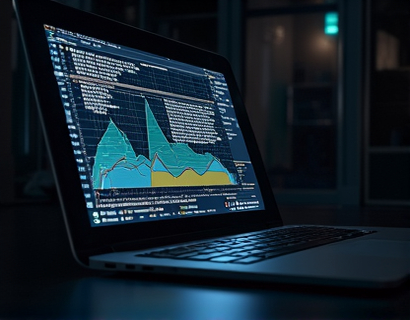Maximizing Digital Asset Value: Smart Contracts for Long-Term UCASH Locking and Sustainable Fintech Growth
In the rapidly evolving landscape of digital finance, the ability to maximize the value of digital assets while ensuring sustainable growth is paramount. One innovative solution that stands out is the use of smart contracts for long-term UCASH locking. This approach not only enhances the value of digital assets but also fosters a robust and thriving community. By leveraging the power of smart contract technology, users can drive sustainable fintech growth and contribute to a more transparent and reliable financial ecosystem.
The concept of locking UCASH, or any digital asset, for a prolonged period using smart contracts is rooted in the principles of decentralized finance (DeFi). Smart contracts are self-executing contracts with the terms of the agreement directly written into code. This technology ensures that all transactions are transparent, immutable, and automatically enforced, eliminating the need for intermediaries and reducing the risk of fraud or manipulation.
Understanding Smart Contracts in Digital Finance
Smart contracts operate on blockchain networks, which provide a decentralized and secure platform for executing agreements. In the context of digital assets, smart contracts can be programmed to lock UCASH or other tokens for a specified duration, ensuring that the assets remain unavailable for trading or other transactions during the lock period. This locking mechanism creates a predictable and stable environment for investors, as it reduces market volatility and provides a clear timeline for returns.
The use of smart contracts in digital finance extends beyond simple locking mechanisms. They can automate a wide range of financial operations, from dividend distributions to liquidation processes. This automation not only increases efficiency but also reduces operational costs, making fintech solutions more accessible and profitable for all participants.
Long-Term UCASH Locking: Benefits and Mechanics
Locking UCASH or similar digital assets for the long term using smart contracts offers several advantages. Firstly, it provides a stable source of returns, as the locked assets are not subject to short-term market fluctuations. This stability is particularly appealing to conservative investors who prioritize capital preservation over speculative gains.
Secondly, long-term locking incentivizes users to hold their digital assets for extended periods, contributing to the overall liquidity and stability of the ecosystem. This behavior aligns with the goals of sustainable fintech growth, as it encourages a more thoughtful and strategic approach to investing. By locking their assets, users become active participants in the ecosystem, rather than passive holders.
From a technical standpoint, the smart contract for UCASH locking would include several key components. Upon deployment, the contract would require the user to deposit a specified amount of UCASH and set a lock duration, typically ranging from a few months to several years. Once the lock period begins, the contract would automatically enforce the terms, preventing any withdrawals or transactions involving the locked assets.
To enhance transparency and trust, the smart contract would be open-source, allowing users to audit the code and verify its functionality. This openness is crucial in building a community that values security and reliability. Additionally, the contract could include features such as periodic interest accrual, where locked UCASH earns additional tokens based on predefined rates, further enhancing the attractiveness of long-term locking.
Fostering a Thriving Community
The implementation of smart contracts for UCASH locking is not just about individual gains; it is also about building a collaborative and thriving community. By incentivizing long-term holding and participation, the ecosystem fosters a culture of mutual benefit and shared growth. Users who lock their assets contribute to the overall stability and attractiveness of the platform, making it more appealing to new participants.
Community-driven initiatives can be integrated into the smart contract framework, such as governance tokens that allow holders to vote on key decisions affecting the ecosystem. This governance model ensures that the community has a say in the direction and development of the platform, promoting a sense of ownership and engagement.
Moreover, the ecosystem can support various decentralized applications (dApps) that leverage the locked UCASH for different purposes, such as lending, staking, or funding community projects. These dApps not only diversify the use cases of the digital assets but also create additional value for the community, further solidifying the ecosystem's resilience and growth potential.
Driving Sustainable Fintech Growth
Sustainable fintech growth is a critical aspect of the digital finance landscape, and smart contracts play a pivotal role in achieving this goal. By automating processes and reducing reliance on intermediaries, smart contracts lower barriers to entry and make financial services more accessible to a broader audience. This democratization of finance is essential for fostering inclusive growth and ensuring that the benefits of digital innovation reach underserved communities.
Furthermore, the use of smart contracts promotes environmental sustainability by reducing the carbon footprint associated with traditional financial systems. The decentralized and efficient nature of blockchain technology minimizes the need for physical infrastructure and energy-intensive processes, aligning with the growing demand for eco-friendly financial solutions.
To maximize the impact of smart contracts in fintech, it is essential to focus on continuous improvement and innovation. This includes developing more sophisticated contract templates, integrating advanced analytics for better decision-making, and exploring interoperability with other blockchain networks. By staying at the forefront of technological advancements, the ecosystem can maintain its competitive edge and drive long-term growth.
Challenges and Considerations
While the benefits of using smart contracts for UCASH locking are significant, there are also challenges and considerations that must be addressed. One of the primary concerns is the technical complexity involved in deploying and managing smart contracts. Users need to have a basic understanding of blockchain and smart contract functionality to fully leverage these tools.
Another challenge is the regulatory environment, which is still evolving in the realm of digital assets and DeFi. Compliance with local and international regulations is crucial to ensure the legitimacy and sustainability of the ecosystem. Engaging with regulatory bodies and staying informed about changes in the legal landscape can help mitigate risks and ensure compliance.
Security is also a paramount concern. While smart contracts are inherently secure due to their immutable nature, vulnerabilities can still exist in the code. Rigorous testing and auditing by reputable third parties are essential to identify and rectify any potential issues before deployment. Additionally, users should be educated on best practices for securing their private keys and managing their digital assets.
Conclusion
Smart contracts offer a revolutionary approach to maximizing the value of digital assets through long-term UCASH locking and sustainable fintech growth. By leveraging the transparency, reliability, and automation provided by blockchain technology, users can achieve stable returns and contribute to a thriving financial ecosystem. As the digital finance landscape continues to evolve, embracing innovative solutions like smart contracts will be crucial for driving sustainable growth and fostering a collaborative community.
Joining this movement means being part of a forward-thinking financial ecosystem that prioritizes transparency, security, and community-driven innovation. By locking their UCASH using smart contracts, users not only secure their investments but also play a vital role in shaping the future of digital finance.









































